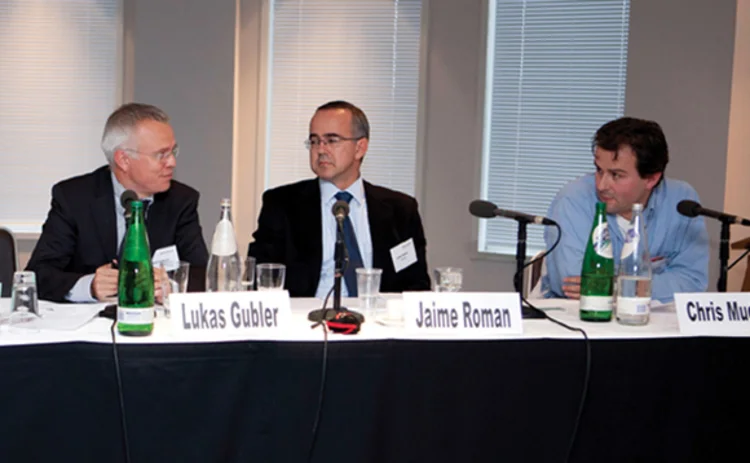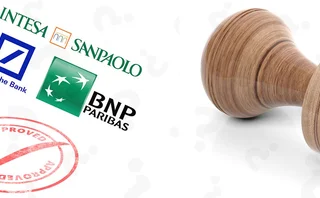
London conference report
Energy risk managers met in London in October for Energy Risk’s Europe 2010 conference to discuss the latest developments and prospects for the energy and commodities markets as the economic recovery takes root amid sweeping regulatory changes. Katie Holliday, Alex Davis and Patrick Blum report

Much of the debate at the conference was on how to respond to the challenges of a hesitant global economic recovery and the wave of new regulation that threatens to push up costs and dampen investment.
The two-day conference started with an overview of developments in the oil sector and the impact on Europe's energy markets. Hussein Allidina, head of commodity research at Morgan Stanley, expressed concern over data showing stagnating oil production in the Organised Economic Co-operation and Development countries. "Our conclusions were dire. Even in a perfect scenario where all the 560 oil fields we analysed were to come online on time, which we in the energy sector know is unlikely, it doesn't look good," he said.
The bulk of demand recovery will come from non-OECD countries, he said, dismissing suggestions China's energy intensity reduction targets would affect its energy demand. "Only 5% of China total product demand is consumed in the industries being targeted for reduced energy intensity. We don't think this will translate into weaker demand growth." In addition, demand growth in Iran, Brazil, Saudi Arabia and India would collectively contribute to as much demand recovery as China.
This was followed by a roundtable looking at gas supply and demand issues. Sabine Schels, senior director in commodities research at Bank of America Merrill Lynch, cautioned that although there was a lot of interest in shale gas outside the US it would be five or more years before it becomes a big factor in Europe. Frederic Lasserre, global head of commodities research at Société Générale Corporate & Investment Banking, said conditions from costs to geography and populations were different in Europe than the US. "In Europe people might be ready to accept higher costs to safeguard security of supplies," he said.
Participants next focused on trading and risk management issues. Rune Nilsen, corporate risk manager of tactical risk at Norwegian oil producer Statoil, provided a case study for best practice risk management at his company. He described how Statoil pulls together various strands of risk to get an overall risk measure. Nilsen said catastrophe risk had become more prominent since recent oil disasters. "The company is more attentive to how it is managing this risk. We discuss the worst that can happen and analyse all the scenarios, looking at historical incidents. We focus on business continuity management - if there is a major disruption, how is it dealt with and how quickly can we get back to full production? All these factors contribute to creating a potential cost."
The conference then examined ways to optimise and hedge power-generation assets. Jaime Román, chief risk manager at Spanish energy company Endesa, gave a joint presentation with Italian energy group Enel's head of risk management, Antonio Scala. They described how energy risk managers had to deal with a wide range of assets, including freight, coal, electricity, pipelines, gas, oil, power generation and logistics. Román said the forwards market for electricity lacked the depth needed for complete freedom in hedging strategies. "We hedge where we can, but the liquidity in the forward electricity market is not deep enough."
A separate panel looked at risk modelling in commodity transactions. Steve Leppard, head of Europe, the Middle East and Africa corporate structuring at JP Morgan, outlined modelling strategies and described how hedging was used to extract value in commodity transactions. But he warned, "You can never hedge anything perfectly. The assumption that you can hedge away all your risk is wrong." He stressed how risk analytics must address more than quantitative risks in derivatives pricing. "Simulation techniques allow us to address many problems that are outside the scope of traditional hedgable derivatives valuation techniques. There will always be a role for human judgement in expressing risk appetite in the face of modelling imperfections, market and physical uncertainty," he said.
After lunch, Vince Kaminski, professor at Rice University's Jesse H Jones Graduate School of Business, gave a presentation on how to deal with the problem of illiquidity in the energy markets. "This is a problem that is endemic to the industry and everybody who has spent a few years in the business has at least one horror story related to illiquidity," he said. The flash crash that took place in the equities markets in May showed that a large volume of trades does not necessarily guarantee liquidity. "Although there was a sequence of transactions between high-frequency traders between 14:45:13 and 14:45:27 on May 6 and more than 27,000 contracts were traded, only 200 contracts were purchased net," said Kaminski. He said risk managers construct sophisticated hedges, but often ignore the cashflow consequences of hedging transactions. One solution to catch liquidity risk is to include it into standard value-at-risk models by recognising that different positions have different liquidation periods.
A roundtable debate on technology followed, moderated by Diana Higgins, risk reporting manager at Centrica Energy. Participants discussed the potential a fully integrated system providing straight-through processing. Roger Donovan, managing director of international operations at SolArc, argued that while it is possible to have automated processes for standardised products, this was not suitable for some commodities markets. The panel examined the merits of buying an industry standard energy trading risk management software system versus building in-house solutions and agreed that if a company has a unique requirement, it should be built in house, but large-scale standardised solutions were better ‘off the shelf'.
The next roundtable examined power market coupling and cross-border trading. Andrea Vittorio Siri, manager in power origination, continental Europe, at Edison Trading, kicked off the discussion with a simple explanation, comparing electricity coupling with a motorway connection. "Moving electricity is much like a motorway connection, but instead of using a motorway you use a cable and you cannot transport as much as you like because there is a physical limit," he said.
Juan Rios, head of European power trading at Spanish utility Iberdrola, examined various initiatives that have taken place in Europe. Guro Grotterud, an analyst at the Energy Regulation Commission in France, followed with a description of how regulators were working to encourage market coupling and a more unified European electricity market. Paul Dawson, head of market design and regulatory affairs at German utility RWE, put the discussion of market coupling into context: "There's a tendency to think market coupling is the thing we're looking for – once we've coupled all these markets we'll have a single European market – but that's not true. Market coupling is one useful element but it's not anywhere near sufficient on its own," he said.
The day's final session was a roundtable of chief risk officers to discuss current challenges in the energy markets. A lively discussion between three chief risk officers at high-profile energy companies, Endesa, Mercuria and EGL, revealed that changes to markets and regulations had made the role of the CRO more difficult. "There is growing pressure on risk managers, as financial markets innovation brings new and more risky products," said Lukas Gubler, chief risk officer at trading energy company EGL. Endesa's Román addressed the impact of regulatory changes. "We are used to managing credit and market risk, and liquidity is part of that. We're familiar with it and we can manage it. The bigger problem is regulatory risk, because you never know what's going to come out. We need to keep an eye on regulation. We don't have a product for hedging against regulation," he said.
Day two
The second day began with a presentation by Stefan Judisch, chief executive officer of RWE supply and trading, on developing the optimum energy portfolio and minimising risk. A company must decide what it wants from its risk management strategy, whether it wants to reduce risks and gain planning security or maximise profit. It should explore asset flexibility, he said. "In the good old days, flexibility in the portfolio was deemed to respond to demand and supply fluctuations. These days you need to understand that you have real options, how you value them, how they behave and then you need to monetise them."
Next followed a keynote speech from Philip Lowe, director-general for energy at the European Commission, about the development of a competitive European energy market. There is still a long way to go to ensure the EU's energy markets are fully integrated and transparent, and a lot of infrastructure needs to be built, he said. "This is why we are constantly working with all stakeholders to establish compatible, forward, day-ahead and intra-day markets for electricity by 2015," he said. He sought to calm fears over planned markets legislation, saying the EC's goal was to enable the markets to be suitably monitored rather than overregulated.
Two separate discussion groups followed. The first group focused on quantitative analysis and modelling. Derek Bunn, professor at the London Business School, discussed various ways of capturing non-linear variables in modelling for price formation. Andras Szell, derivatives specialist at Financial Engineering Associates, looked at models to assess the value of commodities held in storage. Andrea Roncoroni, professor of finance at Essec Business School, later examined approaches to creating flowing VaR, making static risk assessment models dynamic to take account of factors such as seasonality. Mattias Palm, head of markets and sales at Navita Systems, gave a presentation on using IT systems for efficient risk control in a multi-commodity market.
In the second group, participants discussed credit exposure. Michael Carter, director of credit risk at EDF Trading North America, described different ways to manage credit exposure, evaluate counterparty creditworthiness and calculate bilateral collateral and margining. The level of conservatism in financial statements was an issue, he said. "They are not reflective of the true economic state."
The next discussion outlined an airline case study. As their fourth largest cost, fuel is an important risk for airlines to mitigate against. Wolfgang Henle, vice-president of controlling and risk management at Austrian Airlines, described how the company addresses risk factors specific to airlines and how it protects itself against fuel price volatility. He warned: "If everyone in the market is hedging their risks, this can distort the market. Eliminating all the risks in the market could cause a market failure," he said.
Renewable energy was the focus of the next session. Stefan-Jorg Govel, managing director and head of trading and origination at Stakraft Markets, discussed the growth of renewable energy as Europe advances towards meeting its target of generating 20% of its electricity from renewable sources by 2020. "There is a global and stable trend for more renewables," he said, but he warned: "Integrating renewables into the energy system brings big changes. It might eventually mean a paradigm shift for investments in conventional power stations, for fuel markets and the way we organise energy."
In a following panel on energy market dynamics and globalisation, Jogchum Brinksma, managing director of global commodities at Citigroup, discussed the rapid growth of the liquefied natural gas (LNG) market. "The picture has been changing for global LNG. Most of the growth in global liquefaction and re-gas over the next five years will take place in the Pacific."
The conference concluded with a final roundtable on carbon trading post-2012. Participants discussed how the next stage in the EU's Emissions Trading Scheme will change hedging strategies for risk managers. Simone Ruiz, European policy director at the International Emissions Trading Association, said trading will be more secure and there will be a Europe-wide single registry.
A PDF version of this feature covering the Energy Risk Europe 2010 conference is available
Only users who have a paid subscription or are part of a corporate subscription are able to print or copy content.
To access these options, along with all other subscription benefits, please contact info@risk.net or view our subscription options here: http://subscriptions.risk.net/subscribe
You are currently unable to print this content. Please contact info@risk.net to find out more.
You are currently unable to copy this content. Please contact info@risk.net to find out more.
Copyright Infopro Digital Limited. All rights reserved.
You may share this content using our article tools. Printing this content is for the sole use of the Authorised User (named subscriber), as outlined in our terms and conditions - https://www.infopro-insight.com/terms-conditions/insight-subscriptions/
If you would like to purchase additional rights please email info@risk.net
Copyright Infopro Digital Limited. All rights reserved.
You may share this content using our article tools. Copying this content is for the sole use of the Authorised User (named subscriber), as outlined in our terms and conditions - https://www.infopro-insight.com/terms-conditions/insight-subscriptions/
If you would like to purchase additional rights please email info@risk.net
More on Risk management
Falling T2 balances bode well for eurozone’s stability
Impact of fragmentation would be less severe today than in 2010s, says Marcello Minenna
For a growing number of banks, synthetics are the real deal
More lenders want to use SRTs to offload credit risk, but old hands say they have a long road ahead
Did Fed’s stress capital buffer blunt CCAR?
Experts fear flagship test’s use as a capital top-up has undermined its role in risk management
How Ally found the key to GenAI at the bottom of a teacup
Risk-and-tech chemistry – plus Microsoft’s flexibility – has seen US lender leap from experiments to execution
Industry urges focus on initial margin instead of intraday VM
CPMI-Iosco says scheduled variation margin is better than ad hoc calls by clearing houses
Consortium backs BGC’s effort to challenge CME
Banks and market-makers – including BofA, Citi, Goldman, Jump and Tower – will have a 26% stake in FMX
Revealed: the three EU banks applying for IMA approval
BNP Paribas, Deutsche Bank and Intesa Sanpaolo ask ECB to use internal models for FRTB
FICC takes flak over Treasury clearing proposal
Latest plans would still allow members to bundle clearing and execution – and would fail to boost clearing capacity, critics say
Most read
- Podcast: Olivier Daviaud on P&L attribution for options
- For a growing number of banks, synthetics are the real deal
- SG trader dismissals shine spotlight on intraday limit controls







